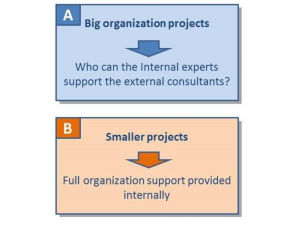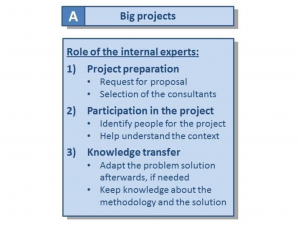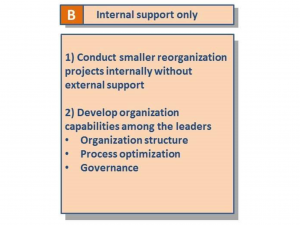In view of the significant budget that many companies dedicate every year to management consulting, a number of companies have created an internal organization expertise. The purpose of this article is to share some thoughts on the benefits that such a team can have (part 1), and to outline recommendations on how to build-up such a team (part 2).
Part 1: What are the benefits of an internal organization team?
Let’s distinguish two different situations to answer that question: (a) The case where a large reorganization project is required and (b) the day to day operations where smaller organization topics need to be addressed.

1. Large organization project
Such large projects are very resource intensive and it is clear that an internal team is usually not sizable enough to cover this fully. In such a situation, the internal and the external consultants should therefore work together. I will outline here why I believe that having such a joint project team can be very beneficial for the company. To do so, I suggest looking at the 3 main steps of the life cycle of such a large project:
• Project preparation
• Project implementation
• Knowledge transfer

1.1. Project preparation
The starting point of any organization initiative is the identification of a need for change and the decision to address this issue. This decision is usually taken by top management. Very often, the first reflex leaders have is to contact consulting firms and to discuss the issue and the way to address them with these consultants. These first interactions lead later to a more detailed briefing of a limited number of consulting firms in order to request a proposal from them.
In many cases, this briefing remains relatively high level and unspecific, because no detailed issue analysis has been conducted beforehand. That is usually due to the fact that (a) the confidentiality of the topic does not allow a broader involvement of employees and (b) because of a lack of organizational expertise that is needed to come up with a more detailed problem understanding. As a result, the issue analysis is largely delegated to the consultants.

You could ask: so what? Isn’t that part of their job to assess the situation before coming up with their recommendations? Yes, of course, they will have to start the project with a detailed problem analysis. But it makes a big difference, if real problem awareness has been established in the company first enhancing its ability to undertake the change. This is part of any change curve that you are certainly aware of. That initial understanding of the issue and of the need for change is a key component of change management. It allows the leaders to confirm and specify the needs analysis and to obtain on that basis a common understanding of the problem. This will also allow obtaining alignment within the leadership team on the decision to start a project and to conduct it with external support.
Delegating this initial assessment completely to the external consultants is one of the reasons why the implementation of project recommendations is often not very satisfactory. This is usually due to the fact that the initial buy-in has been missed. The company’s ability to gain a true understanding of the issue and to share this at least within the broader top management in order to obtain a common commitment for change is therefore an important step of the project itself, which cannot be completely externalized.

The internal consulting team can therefore play an important role in this preparation phase. They can conduct such an issue analysis before external consultants are contacted. This more specific issue analysis can then be integrated into the Request For Proposal (RFP), which is used as a basis for the selection of the external consultant. This is usually a much better basis to define the nature and scope of the project. The more specific that request will be, the clearer the proposition from the pitching consulting firms will be. This more detailed description of the needs will also allow to engage with the consultants during the selection phase in more in-depth discussions and to evaluate the different consulting propositions. The quality of the selection process itself will thereby be improved.
1.2 Project implementation
As mentioned above, large organization projects are usually very resource intensive and it is clear that the internal organization team cannot provide the full staffing. But they can and should be part of the project team and should work closely with the external consultants.

As a matter of fact, their knowledge of the company and of its ways of working can be of great support for the external consultants. The internal team can help identify the appropriate people to contact in the organization in view of information needed and can advise who to involve in certain parts of the project. They can also help ensure regular communication to the different parts of the company concerned by that change initiative.
1.3 Knowledge transfer
The question of knowledge transfer is of particular importance. A lot of knowledge is generated during the course of such a project and usually walks out of the door, when the consultants leave the company. Of course, most of the analysis is documented in project presentations, but only those who have been involved in the project itself will have the insight leverage on that analysis in the future. Otherwise, the documents become quickly obsolete and large electronic files get lost in the data jungle.

Sustainability of the consulting recommendations is sometimes quite limited, because nobody inside the company is able to adjust the consulting recommendations to new requirements, if a change in the business environment occurs. The only solution is to bring the consultants back in, which can make the company dependent on these external interventions. The role of the internal consultants as members of the joint project team is therefore to absorb this knowledge in order to be able to adjust the organizational solution to new requirements after the consultants have left. That includes transferring the knowledge about the methodology that has been used during the project, the knowledge concerning the issue analysis and the assumptions that have been made during the development of the solution.
On that basis, the internal team will be able to do the post project maintenance. This will contribute to making the outcomes of the consulting intervention more sustainable and will thereby help increase the return of that consulting investment.
2 Smaller organization projects
In case of smaller organizational adjustments, the internal team can be expected to conduct them without any external support.

As a matter of fact, conducting such projects in a more autonomous way can have many advantages. In case more resources are required to conduct certain project tasks, a higher level of involvement of people from the departments concerned by the change initiative can be quite beneficial. The role of the internal consulting team can be to provide methodological support, to ensure the project management and to be involved in the project work, but in a participative way instead of “doing on behalf”. Even if that approach might take a bit longer in the problem analysis and in the definition of the recommendations, it will usually lead to a much higher level of buy-in from the people concerned and thereby help accelerate the implementation phase.

In addition to the support of specific projects or change initiatives, the internal organization experts can also help build up the organization capabilities within the company. That is particularly important for the leadership population, where a better insight in the different facets of organizational optimization (including structure, processes, skills and company culture, see my article on Organization Design) can allow making organization effectiveness a permanent topic instead of undertaking the ad hoc changes only when the issues have become urgent.
Finally, senior leaders can take advantage of having the internal organization experts as sparing partners, with whom they can bounce ideas back and forth. Such exchanges can be very fruitful and can help anticipate organizational adjustments early on. Such a proactive approach based on the internal understanding of the current and future business requirements can make the change journey much less disruptive.
3 Conclusion
Based on this, I suggest that it can be beneficial to have internal organization expertise in place. That internal expertise will certainly not substitute external interventions in case of large projects, but can play an important role as members of such projects. Outside of large change initiatives, the internal organization team can lead organization projects without external support. This team can also help raise the organizational understanding of leaders in your company, which will help anticipate change requirements and make organizational adaptation less disruptive.
This leads to the second question: How to build such a team? That will be covered in part 2.
More information in my book:
Sven Sommerlatte : Successful Career Strategy – An HR Practitioner’s Guide to Reach Your Dream Job (Springer, June 2023). ISBN: 978-3-662-66790-3
